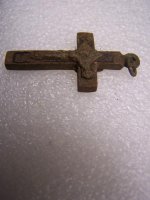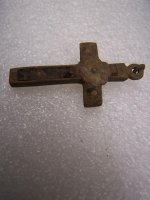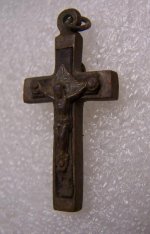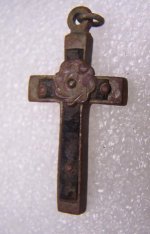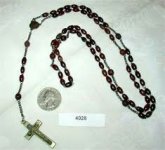You are using an out of date browser. It may not display this or other websites correctly.
You should upgrade or use an alternative browser.
You should upgrade or use an alternative browser.
What type of metal is this crucifix pendant I dug?
- Thread starter CarlessDetector
- Start date
CarlessDetector
New Member
By the way
It is not magnetic, and has been in the ground at least 25 years
It is not magnetic, and has been in the ground at least 25 years
brass?
Brass or some copper alloy would be my guess as well.
CarlessDetector
New Member
Thanks for the info
I just looked up brass crucifix's and saw that this is some variation of ebony wood inlaid brass. I didn't see one quite the same though. Still my best find ever so far! Cool. I'm still questioning a bit what type of metal this is exactly though, it has such red spots, but is not magnetic?
I just looked up brass crucifix's and saw that this is some variation of ebony wood inlaid brass. I didn't see one quite the same though. Still my best find ever so far! Cool. I'm still questioning a bit what type of metal this is exactly though, it has such red spots, but is not magnetic?
CarlessDetector
New Member
Bayoutalker
Elite Member
Looks like a crucifix from a rosary.
Cliff
Ya think?
OP, I would guess that it could be an alloy similar to pewter.
SageGrouse
Elite Member
I've seen, and owned many of these. The materials I have seen include brass, aluminum and "German silver" which is a nickel alloy, NOT actual silver.
The skull and crossbones sometimes seen below the Corpus' feet has two significances: 1. Jesus' triumph over death and the grave. 2. Supposedly the hill of calvary is directly over the grave of Adam (yes that adam) and thus symbolizes Christ's death in atonement for Original Sin.
Above the Corpus of course is the titular. INRI ("Iesvs Nazarenvs Rex Iudaeorvm" ) or "Jesus, Nazarene, King of the Jews"
The round symbol on the back is of course the crown of thorns. In many of the crucifices of this inlaid type, the 'nails' go all the way through, from front to back, so that they may be individually reverenced when the crucifix is turned over.
I don't know what the inlay is made of, but the ones I have seen, they *all* look as if the inlay had been a liquid, poured into the metal frame, and then embellished while the substance was still semi soft. Like a heavy plasticized clay. This may be an imitation of the silver and ebony originals, which of course are a way to reverence the wooden nature of the crucifix.
Such inlaid crucifices are often called "Nun's Crucifix" or "Priest's Crucifix" althought they may be worn or carried by anyone.
The age is usually Victorian or early twentieth century. I do not think they make them now. They are certainly VERY striking.
"Pie Iesu Domine! ~ WHACK! ~ Dona eis Requiem! ~ WHACK!!"
https://www.youtube.com/watch?v=YgYEuJ5u1K0
SageGrouse
The skull and crossbones sometimes seen below the Corpus' feet has two significances: 1. Jesus' triumph over death and the grave. 2. Supposedly the hill of calvary is directly over the grave of Adam (yes that adam) and thus symbolizes Christ's death in atonement for Original Sin.
Above the Corpus of course is the titular. INRI ("Iesvs Nazarenvs Rex Iudaeorvm" ) or "Jesus, Nazarene, King of the Jews"
The round symbol on the back is of course the crown of thorns. In many of the crucifices of this inlaid type, the 'nails' go all the way through, from front to back, so that they may be individually reverenced when the crucifix is turned over.
I don't know what the inlay is made of, but the ones I have seen, they *all* look as if the inlay had been a liquid, poured into the metal frame, and then embellished while the substance was still semi soft. Like a heavy plasticized clay. This may be an imitation of the silver and ebony originals, which of course are a way to reverence the wooden nature of the crucifix.
Such inlaid crucifices are often called "Nun's Crucifix" or "Priest's Crucifix" althought they may be worn or carried by anyone.
The age is usually Victorian or early twentieth century. I do not think they make them now. They are certainly VERY striking.
"Pie Iesu Domine! ~ WHACK! ~ Dona eis Requiem! ~ WHACK!!"
https://www.youtube.com/watch?v=YgYEuJ5u1K0
SageGrouse
BufordCityDawg
Elite Member
I've seen, and owned many of these. The materials I have seen include brass, aluminum and "German silver" which is a nickel alloy, NOT actual silver.
The skull and crossbones sometimes seen below the Corpus' feet has two significances: 1. Jesus' triumph over death and the grave. 2. Supposedly the hill of calvary is directly over the grave of Adam (yes that adam) and thus symbolizes Christ's death in atonement for Original Sin.
Above the Corpus of course is the titular. INRI ("Iesvs Nazarenvs Rex Iudaeorvm" ) or "Jesus, Nazarene, King of the Jews"
The round symbol on the back is of course the crown of thorns. In many of the crucifices of this inlaid type, the 'nails' go all the way through, from front to back, so that they may be individually reverenced when the crucifix is turned over.
I don't know what the inlay is made of, but the ones I have seen, they *all* look as if the inlay had been a liquid, poured into the metal frame, and then embellished while the substance was still semi soft. Like a heavy plasticized clay. This may be an imitation of the silver and ebony originals, which of course are a way to reverence the wooden nature of the crucifix.
Such inlaid crucifices are often called "Nun's Crucifix" or "Priest's Crucifix" althought they may be worn or carried by anyone.
The age is usually Victorian or early twentieth century. I do not think they make them now. They are certainly VERY striking.
"Pie Iesu Domine! ~ WHACK! ~ Dona eis Requiem! ~ WHACK!!"
https://www.youtube.com/watch?v=YgYEuJ5u1K0
SageGrouse
Great explanation AND a Monty Python reference in the same post. You are my hero.
BCD
OleSarge
Elite Member
I've seen....
The skull and crossbones... 2. Supposedly the hill of calvary is directly over the grave of Adam (yes that adam) and thus symbolizes Christ's death in atonement for Original Sin.
Above.....
The round....
I don't know....
Such inlaid crucifices...
The age..
"Pie Iesu Domine! ~ WHACK! ~ Dona eis Requiem! ~ WHACK!!"
https://www.youtube.com/watch?v=YgYEuJ5u1K0
SageGrouse
Amazing post which pretty well summizes my own sentiments about finding articles which others may consider trinkets or junk.
The reference to Adam is totally new to me and deserves to be the first stop on a long trip to further examine this interesting aspect of religious lore.
AT Pro/GPP/Fiskars Diggers
OleSarge
Elite Member
I haven't cleaned it at all yet, but i might
Personally, if it were me I'd leave it exactly as it is.
The layer of patena lends itself to the character of the cross, and even in pristine condition probably wouldn't add anything to its melt value or appeal as a relic.
According to the funeral director at the New Tacoma Cemetery, they discourage metallic articles being included in the casket during the cremation of human remains.
But, probably more frequently than they care to admit, articles such as the crucifix are sent to the oven with the remains.....and, consequently, would be spread with the ashes.
So, the guess of it being in the ground for 25 years may be slightly exaggerated by the effects of exposure to a short burst of intense heat during a more recent time.
No morbidity intended.......congratulations on a very interesting find.
AT Pro/GPP/Fiskars Diggers
metaladdict
Elite Member
Looks like brass or copper.
Similar threads
- Replies
- 7
- Views
- 80


